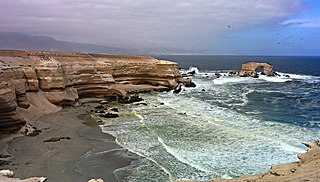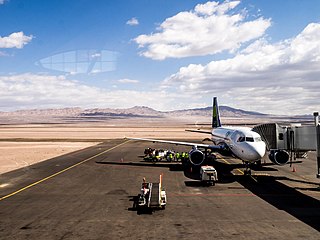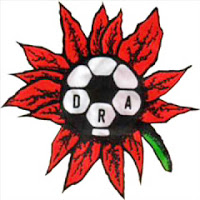
Chile, officially the Republic of Chile, is a country located in western South America. It is the southernmost country in the world and closest to Antarctica, stretching along a narrow strip of land between the Andes Mountains and the Pacific Ocean. With an area of 756,096 square kilometers (291,930 sq mi) and a population of 17.5 million as of 2017, Chile shares borders with Peru to the north, Bolivia to the northeast, Argentina to the east, and the Drake Passage to the south. The country also controls several Pacific islands, including Juan Fernández, Isla Salas y Gómez, Desventuradas, and Easter Island, and claims about 1,250,000 square kilometers (480,000 sq mi) of Antarctica as the Chilean Antarctic Territory. The capital and largest city of Chile is Santiago, and the national language is Spanish.

The Antofagasta Region is one of Chile's sixteen first-order administrative divisions. The second-largest region of Chile in area, it comprises three provinces, Antofagasta, El Loa and Tocopilla. It is bordered to the north by Tarapacá, by Atacama to the south, and to the east by Bolivia and Argentina. The region's capital is the port city of Antofagasta; another one of its important cities is Calama. The region's main economic activity is copper mining in its giant inland porphyry copper systems.

The Atacama Region is one of Chile's 16 first order administrative divisions. It comprises three provinces: Chañaral, Copiapó and Huasco. It is bordered to the north by Antofagasta, to the south by Coquimbo, to east with Provinces of Catamarca, La Rioja and San Juan of Argentina, and to the west by the Pacific Ocean. The regional capital Copiapó is located at 806 km (501 mi) north of the country's capital of Santiago. The region occupies the southern portion of the Atacama Desert, the rest of the desert is mainly distributed among the other regions of Norte Grande.

The flag of Chile consists of two equal-height horizontal bands of white and red, with a blue square the same height as the white band in the canton, which bears a white five-pointed star in the center. It was adopted on 18 October 1817. The Chilean flag is also known in Spanish as La Estrella Solitaria.

A province is the second-largest administrative division in Chile with 56 in total. The largest administrative division in Chile is that of a region with 16 in total.

Copiapó is a city and commune in northern Chile, located about 65 kilometers east of the coastal town of Caldera. Founded on December 8, 1744, it is the capital of Copiapó Province and Atacama Region.

Antofagasta Province is one of three provinces in the northern Chilean region of Antofagasta (II). The capital is the port city of Antofagasta. Located within the Atacama Desert, it borders the El Loa and Tocopilla provinces to the north, the Pacific Ocean to the West and the Atacama Region to the south.

Caldera is a port city and commune in the Copiapó Province of the Atacama Region in northern Chile. It has a harbor protected by breakwaters, being the port city for the productive mining district centering on Copiapó to which it is connected by the first railroad constructed in Chile.

Deportes Antofagasta is a Chilean football club based in the city of Antofagasta currently playing in the Campeonato Nacional. The club's home stadium is the Estadio Bicentenario Calvo y Bascuñán, which has a capacity of 21,178.

Club de Deportes Copiapó — or simply Deportes Copiapó — is a Chilean football club based in Copiapó, Atacama Region. Founded in 1999 after Regional Atacama's folding, it currently plays in the Primera División, the first level of the Chilean football system, and holds its home games at Estadio Luis Valenzuela Hermosilla which has a capacity of 8,000 spectators.

Copiapó Province is one of three provinces of the northern Chilean region of Atacama (III). Its capital is the city of Copiapó.

Desierto de Atacama Airport is an airport serving the region around Copiapó, the capital of the Atacama Region of Chile. The airport is in the desert north of the Copiapó River, 16 kilometres (9.9 mi) inland from the Pacific coast.

The Atacama Desert is a desert plateau located on the Pacific coast of South America. Stretching over a 1,600 km (990 mi) strip of land west of the Andes Mountains, it covers an area of 105,000 km2 (41,000 sq mi), which increases to 128,000 km2 (49,000 sq mi) if the barren lower slopes of the Andes are included.

This is a summary of the history of Ecuador from 1860 to 1895. Gabriel García Moreno is the father of Ecuadorian conservatism and no doubt the most controversial figure in the nation's history, condemned by Liberal historians as Ecuador's worst tyrant but exalted by Conservatives as the nation's greatest nation-builder. In the end, both appraisals may be accurate; the man who possibly saved Ecuador from disintegration in 1859 and then ruled the nation with an iron fist for the subsequent decade and a half was, in fact, an extremely complicated personality. Born and raised under modest circumstances in Guayaquil, he studied in Quito, where he married into the local aristocracy, then traveled to Europe in the aftermath of the 1848 revolutionary uprisings and studied under the eminent Catholic theologians of the day.

Regional Atacama was a Chilean football club based in the city of Copiapó, Atacama Region. The club was founded in 1979, playing a total of six season at the top level of Chilean football during its 18-year existence.

The Flag of Magallanes y la Antártica Chilena Region is one of the regional symbols of the Chilean Magallanes y la Antártica Chilena Region. This flag was adopted in 1997 by the regional government, also with the Regional Coat of Arms.

The flag of the Los Ríos Region is one of the regional symbols of the Chilean Los Ríos Region.

A desert bloom is a climatic phenomenon that occurs in various deserts around the world. The phenomenon consists of the blossoming of a wide variety of flowers during early-mid spring in years when rainfall is unusually high.
The Chilean Revolution of 1859 was the second attempt by the Chilean Liberals to overthrow their country's Conservative government. Like the first attempt in 1851, it ended in failure. 5,000 people were killed during the fighting.

















